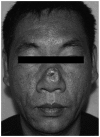Treatment of nasal microcystic adnexal carcinoma with an expanded rotational forehead skin flap: A case report and review of the literature
- PMID: 26622465
- PMCID: PMC4533210
- DOI: 10.3892/etm.2015.2614
Treatment of nasal microcystic adnexal carcinoma with an expanded rotational forehead skin flap: A case report and review of the literature
Abstract
Microcystic adnexal carcinoma (MAC) is a rare and locally aggressive adenocarcinoma with low-grade malignancy. The present study describes the first reported case and treatment of a Chinese male with a MAC located on the nasal dorsum and nosewing. A 44-year-old man presented with a nasal deformity caused by local repeated infections following an accidental injury to the nose 20 years previously. The nose had been injured by a brick, and treatment at a local hospital 12 years previously had resulted in a nasal scar and a gradually enlarging mass. A physical examination revealed a hypertrophic deformity of the nose and an indurated scar plaque, measuring 2.0×2.0 cm, on the nasal dorsum and nosewing. Microscopic examination revealed a tumor consisting of solid cell nests and a cystic structure with a capsular space. In addition, ductal cells of an adnexal cell origin were visible in the outer epithelium. The medial portion exhibited a microductal structure and invasion of deeper tissues without evident atypia. The tumor cells presented normal nuclear to cytoplasmic ratios and minimal mitotic activity. Pathological examination verified that the tumor was a MAC of low-grade malignancy. A complete surgical resection was performed via Mohs micrographic surgery (MMS), and reconstruction was achieved using an expanded rotational forehead skin flap. No tumor recurrence was detected after a three-year follow-up period. Therefore, for effective treatment of similar MAC cases, complete surgical resection using MMS is recommended, and successful reconstruction may be achieved using an expanded skin flap.
Keywords: Mohs micrographic surgery; microcystic adnexal carcinoma; rotational forehead skin flap.
Figures






References
-
- Yu JB, Blitzblau RC, Patel SC, Decker RH, Wilson LD. Surveillance, Epidemiology, and End Results (SEER) database analysis of microcystic adnexal carcinoma (sclerosing sweat duct carcinoma) of the skin. Am J Clin Oncol. 2010;33:125–127. - PubMed
LinkOut - more resources
Full Text Sources
Other Literature Sources
